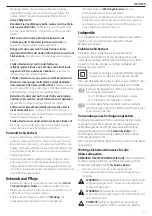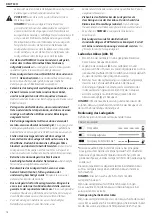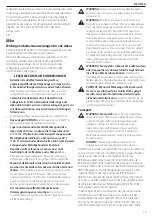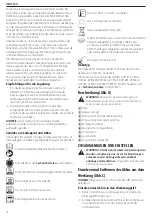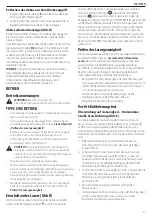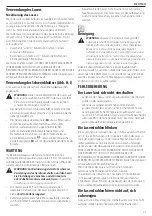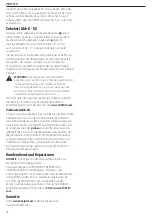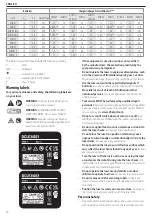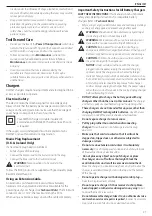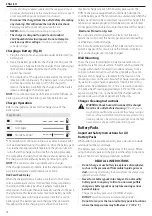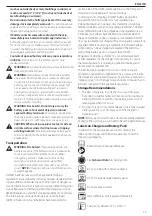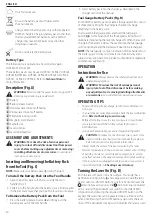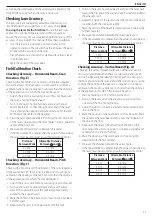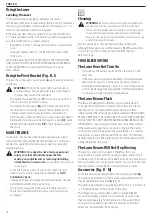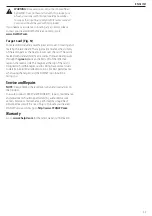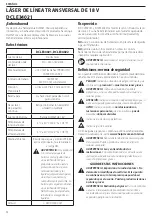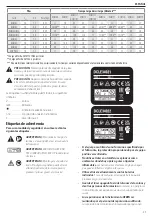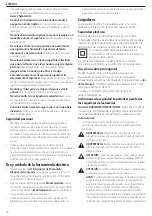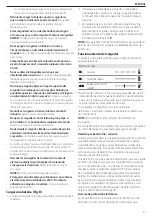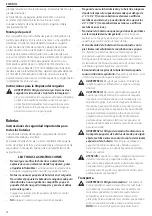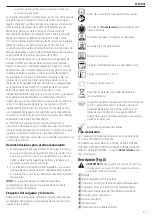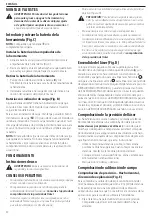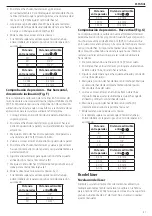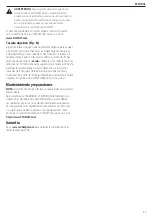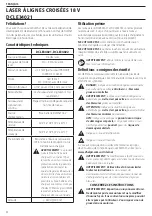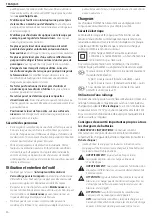
31
EngLIsh
5. Turn on the laser's horizontal beam and pivot the laser back
toward the first end of the wall and approximately parallel to
the adjacent wall.
6. Adjust the height of the laser so that the center of the beam
is aligned with the nearest mark (b).
7. Mark the center of the beam (c) directly above or below the
farthest mark (a).
8. Measure the distance between these two marks (a, c).
• If the measurement is greater than the values shown below,
the laser must be serviced at an authorized service center.
Distance
Between Walls
allowable Distance
Between
a
and
b
10 m
6.0 mm
12.0 m
7.2 mm
15.0 m
9.0 mm
Checking Accuracy – Vertical Beam (Fig. G)
Checking the vertical (plumb) calibration of the laser can be
most accurately done when there is a substantial amount of
vertical height available, ideally 20' (6 m), with one person on
the floor positioning the laser and another person near a ceiling
to mark the position of the beam. It is important to conduct a
calibration check using a distance no shorter than the distance
of the applications for which the tool will be used.
1. Start by marking a 5' (1.5 m) line on the floor.
2. Turn on the laser's vertical beam and position the unit at
one end of the line, facing the line.
3. Adjust the unit so its beam is aligned and centered on the
line on the floor.
4. Mark the position of the laser beam on the ceiling (a). Mark
the center of the laser beam directly over the midpoint of
the line on the floor.
5. Reposition the laser at the other end of the line on the
floor. Adjust the unit once again so its beam is aligned and
centered on the line on the floor.
6. Mark the position of the laser beam on the ceiling (b),
directly beside the first mark (a).
7. Measure the distance between these two marks.
• If the measurement is greater than the values shown below,
the laser must be serviced at an authorized service center.
Distance
Between Walls
allowable Distance
Between
a
and
b
2.5 m
3.4 mm
3.0 m
4.2 mm
4.0 m
5.5 mm
6.0 m
8.2 mm
Field Calibration Check
Checking Accuracy – Horizontal Beam, Scan
Direction (Fig. E)
Checking the horizontal scan calibration of the laser requires
two walls at least 30' (9 m) apart. It is important to conduct a
calibration check using a distance no shorter than the distance
of the applications for which the tool will be used.
1. Attach the laser to a wall using its pivot bracket. Make sure
the laser is facing straight ahead.
2. Turn on the laser's horizontal beam and pivot the laser
approximately 45˚ so that the right-most end of the laser
line is striking the opposing wall at a distance of at least 30'
(9 m). Mark the center of the beam (a).
3. Pivot the laser approximately 90˚ to bring the left-most end
of the laser line around to the mark made in Step 2. Mark the
center of the beam (b).
4. Measure the vertical distance between the marks.
• If the measurement is greater than the values shown below,
the laser must be serviced at an authorized service center.
Distance
Between Walls
allowable Distance
Between
a
and
b
10.0 m
3.0 mm
12.0 m
3.6 mm
15.0 m
4.5 mm
Checking Accuracy – Horizontal Beam, Pitch
Direction (Fig. F)
Checking the horizontal pitch calibration of the laser requires a
single wall at least 30' (9 m) long. It is important to conduct a
calibration check using a distance no shorter than the distance
of the applications for which the tool will be used.
1. Attach the laser to one end of a wall using its pivot bracket.
2. Turn on the laser's horizontal beam and pivot the laser
toward the opposite end of the wall and approximately
parallel to the adjacent wall.
3. Mark the center of the beam at two locations (a, b) at least
30' (9m) apart.
4. Reposition the laser to the opposite end of the wall.
Checking Laser Accuracy
The laser tools are sealed and calibrated at the factory. It is
recommended that you perform an accuracy check
prior
to using the laser for the first time
(in case the laser was
exposed to extreme temperatures) and then regularly to
ensure the accuracy of your work. When performing any of the
accuracy checks listed in this manual, follow these guidelines:
• Use the largest area/distance possible, closest to the
operating distance. The greater the area/distance, the easier
to measure the accuracy of the laser.
• Place the laser on a smooth, flat, stable surface that is level
in both directions.
• Mark the center of the laser beam.
as locking the pendulum, and should always be placed in the
LOCKED/OFF position when the laser is not in use.
Summary of Contents for DCLE34021
Page 1: ...DCLE34021 DCLE34022 ...
Page 3: ...1 Fig A 6 7 3 4 5 1 2 8 9 ...
Page 4: ...2 Fig B Fig C Fig D 1 2 14 5 3 4 3 3 4 4 ...
Page 6: ...4 Fig G Fig H Fig I a b a b STEP 1 STEP 4 STEPS 2 3 STEP 5 STEP 7 STEP 6 7 6 10 11 12 ...
Page 7: ...5 Fig J Fig M Fig K Fig L Fig N FLASHING FLASHING 4 13 6 ...

